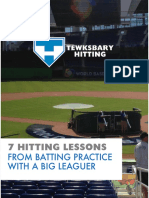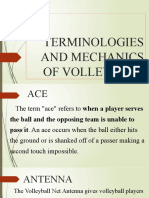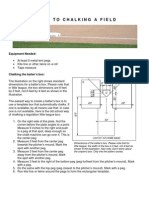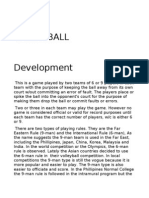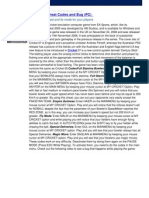Volleyball Study Guide
Volleyball Study Guide
Uploaded by
api-214829206Copyright:
Available Formats
Volleyball Study Guide
Volleyball Study Guide
Uploaded by
api-214829206Original Title
Copyright
Available Formats
Share this document
Did you find this document useful?
Is this content inappropriate?
Copyright:
Available Formats
Volleyball Study Guide
Volleyball Study Guide
Uploaded by
api-214829206Copyright:
Available Formats
Volleyball Study Guide THE GAME A regulation game of volleyball is played by two teams of six players.
Three players are in the front row and three are in the back row. The ball is put into play with a serve by the player in the right back position. When the ball is served, the receiving person typically uses a forearm pass or overhead pass to pass the ball to the setter. The setter attempts to set the ball to a hitter. The hitter attempts to hit the ball onto an open area on the opponents side of the court. The play continues until one team is unable to return the ball, hits the ball out-of-bounds, or a fault is called by the referee. Rally scoring is used. If the serving team wins the rally, they are awarded a point and the same player will serve again. If the receiving team wins the rally, they are awarded a point AND the serve. They will rotate one position, clockwise, and the person who has rotated to the right back position will serve the ball. With rally scoring, games are played to 25 points and must be won by 2 points. VOLLEYBALL SKILLS Forearm Pass: A pass made off the forearms. Often used to pass a served ball, a hard driven spike or any low ball. Overhead Pass: Pass made by contacting the ball above the head with the pads of the fingers. Can be used to pass a served ball or any ball coming above the head. Set: An overhead pass used with the intention of placing the ball in a position to be hit/ spiked. Often the second contact made by a team. Hit/Spike: A ball hit with strong downward force into the opponents court. This is the ideal third hit because it is more difficult for the other team to return. Front row players are allowed to spike the ball from anywhere on the court. Back row players must be behind the attack line when taking off to spike a ball. Block: Placing the hands above the net in order to stop a ball that has been hit/spiked by an opponent so that ideally it will rebound back into the opponents court, or will at least lessen the force if the ball rebounds off the blocker's hands back into their own court. The block DOES NOT count as a hit. Back row players are NOT allowed to block.
Serve: The method of putting the ball into play over the net by striking it with the hand. BASIC RULES OF VOLLEYBALL The Serve 1. Players must serve in rotating order (clockwise rotation). 2. At the time of the serve all players must be in their proper position on the court. 3. After the serve, all players may move to play the ball or move to cover a different area of the court. However, a back row player may not block at the net and must be behind the attack line when taking off to jump and spike a ball.
4.
The server may not step on or over the end line before the ball is contacted the serve. This is called foot fault. 5. On a Jump Serve, the server may not step on or over the end line during takeoff, but CAN land on or over the end line. 6. A served ball that hits the net and goes over within the boundary lines is considered a good serve. 7. In gym class, if the serve hits the basketball hoop, it is a replay (re-do). 8. A serve landing ON the boundary line is considered IN. If a served ball land out-ofbounds, the other team is given a point and awarded the next serve.
Volleying 1. During play, a player may step on the center line (the line directly under the net) but the foot cannot cross the center line entirely. If it does, it is also called a "foot fault". The center line divides the 2 sides of the court and is located directly below the net (see court diagram below). 2. No player may touch the net at any time. A player may follow through over the net when hitting or blocking a ball as long as they dont touch the net. 3. Volleyballs landing on the end line or sideline are considered IN. 4. During a volley, the ball may touch the net and be played off the net. 5. Each time a team receives the ball they may only hit it 3 times. A block is not counted as one of the 3 hits. 6. The same player may not hit the ball twice in a row. 7. When a ball crosses the net, it must cross the net between the antennas (the antennas are directly over the sidelines). If the ball crosses the net outside the antenna, it is considered out-of-bounds. 8. At anytime during play the ball hits the antenna, it is considered out-of-bounds. 9. A lift is called when the ball is hit with open hands (palms up) from underneath. A lift is also called when a player attempts to overhead pass and contacts the ball from below the forehead. 10. A carry is called when a player holds, catches or throws the ball. 11. You are not allowed to block or spike a serve.
The Court
VOLLEYBALL VOCABULARY
"Ace" Fault
A serve that score a point without the opposition being able to play the ball. An infraction of the rules or failure to play the ball properly; point is awarded to the team NOT in error. When a player holds, catches, or throws the volleyball. It is a "fault".
Carry Lift
Contacting the ball from underneath with open hands, palms facing up. This term also applies to contacting the ball from below the forehead when trying to overhead pass or set the ball. Both are considered a "fault". Double Hit When a player contacts the ball twice in a row. Or, an uneven contact where the ball hits off one hand before the other or hits off one arm before the other. Both are considered a "fault". It is LEGAL to have a double contact when passing a served ball or a ball that has been hit (spiked); for example, the ball contacts the passer's forearms then bounces off the upper arms. Foot Fault Stepping on or over the end line when serving the ball. Or, when the foot of any player on the court crosses completely over the center line (the line under the net). "Stuff When a player blocks a spiked ball and the ball lands on the hitter's side of the court. Rally The period of time from when the ball is served until the play is over. Rally Scoring A method of scoring where a point is awarded after every rally, no matter which team served the ball. Kill Dig Tip A shot the opposing team is unable to return, most often a hit/spike. Passing a ball that has been forcefully hit (spiked). A one-handed soft shot hit into the opponents court using the fingertips.
Attack Line A line on the court that is 3 meters (approx. 10 ft.) away from the center line and runs from sideline to sideline (see court diagram above). Match A set of volleyball games played by one team against another team. High school varsity matches consist of the best 3 out of 5 games. Freshman and JV matches consist of the best 2 out of 3 games.
You might also like
- 7 Hitting Lessons Tewksbary HittingDocument13 pages7 Hitting Lessons Tewksbary HittingAnonymous PDEpTC4No ratings yet
- Table Tennis TerminologiesDocument16 pagesTable Tennis TerminologiesJohn Philip Neri BesedillasNo ratings yet
- Volleyball Rules and RegulationsDocument18 pagesVolleyball Rules and RegulationsCali Jaraula91% (11)
- Sports Writing For GlanDocument63 pagesSports Writing For GlanAvigael C. SiraNo ratings yet
- LCCC Campus MapDocument1 pageLCCC Campus MapmatsciNo ratings yet
- Softball BrochureDocument2 pagesSoftball Brochureapi-302159758No ratings yet
- 2010 MIL Media GuideDocument368 pages2010 MIL Media GuideRyan KoehlerNo ratings yet
- Volleyball: Nature and PurposeDocument4 pagesVolleyball: Nature and PurposeFour EyesNo ratings yet
- Volleyball Study GuideDocument3 pagesVolleyball Study GuideLevirisa ManamtamNo ratings yet
- Volleyball Study GuideDocument3 pagesVolleyball Study GuidecdvfrgvNo ratings yet
- Volleyball: History Basic Skills Rules of The GameDocument28 pagesVolleyball: History Basic Skills Rules of The GameHella Mae RambunayNo ratings yet
- BASIC-TERMINOLOGY-OF-VOLLEYBALL-REPORTER-IIDocument39 pagesBASIC-TERMINOLOGY-OF-VOLLEYBALL-REPORTER-IIeirenehope3No ratings yet
- VolleyballDocument18 pagesVolleyballVincent FranciscoNo ratings yet
- Volleyball: Objective of The GameDocument3 pagesVolleyball: Objective of The GameEden AniversarioNo ratings yet
- Volleyball 111111014852 Phpapp02Document23 pagesVolleyball 111111014852 Phpapp02Russian ThomasNo ratings yet
- Volleyball HandoutDocument2 pagesVolleyball HandoutArt Montallana PomarejosNo ratings yet
- Module 1 SportsDocument21 pagesModule 1 SportsVincent FranciscoNo ratings yet
- VolleyballDocument15 pagesVolleyball27.Vanshika SharmaNo ratings yet
- Volleyball HandoutDocument4 pagesVolleyball HandoutJihanesolaNo ratings yet
- Volleyball PPTDocument10 pagesVolleyball PPTJednick Cahinusayan100% (1)
- VOLLEYBALLDocument10 pagesVOLLEYBALLGeneroso A Pelayo IINo ratings yet
- Volleyball Teachers GuideDocument1 pageVolleyball Teachers Guideapi-19307690No ratings yet
- The Six Basic Volleyball Skills Are Passing, Setting, Spiking, Blocking, Digging, and ServingDocument8 pagesThe Six Basic Volleyball Skills Are Passing, Setting, Spiking, Blocking, Digging, and ServingVincent TigueloNo ratings yet
- PDF 20230515 204804 0000Document18 pagesPDF 20230515 204804 0000Vicenty VillamorNo ratings yet
- Pastel Cute Group Project Presentation - 20240318 - 134914 - 0000Document44 pagesPastel Cute Group Project Presentation - 20240318 - 134914 - 0000Ashley Nicole RiveraNo ratings yet
- Hope2 q2 w3 4 LessonDocument6 pagesHope2 q2 w3 4 LessonLucky G. RupersoNo ratings yet
- Volleyball Terminology and GlossaryDocument2 pagesVolleyball Terminology and GlossaryMegz OkadaNo ratings yet
- Volleyball and BasketballDocument10 pagesVolleyball and BasketballthevampsxNo ratings yet
- Volleybal Rules and TermsDocument12 pagesVolleybal Rules and TermsAnn AzarconNo ratings yet
- VOLLEYBALLDocument6 pagesVOLLEYBALLBluei Kallix AzulNo ratings yet
- Volleyball Rules and RegulationsDocument18 pagesVolleyball Rules and RegulationsELLAJEAN GALLOGONo ratings yet
- Pe4 - Group 3 - AttackingDocument10 pagesPe4 - Group 3 - AttackingKim TanjuanNo ratings yet
- Volleyball TerminologyDocument9 pagesVolleyball TerminologyClarice Rapal Velarde100% (1)
- VolleyballDocument2 pagesVolleyballAnthony Malanog SalinoNo ratings yet
- O VolleyballDocument16 pagesO VolleyballRui Borges100% (1)
- JargonsDocument8 pagesJargonsXiasamaNo ratings yet
- Hs Volleyball: SkillsDocument3 pagesHs Volleyball: Skillsanon-579447No ratings yet
- Basic Volleyball Rules and Terminology 2021Document8 pagesBasic Volleyball Rules and Terminology 2021Jowen Para CruzNo ratings yet
- Bahauddin Zakariya Univeristy Multan: Assignment On Specialization in Game VolleyballDocument4 pagesBahauddin Zakariya Univeristy Multan: Assignment On Specialization in Game VolleyballI Tech Services KamranNo ratings yet
- PenaltyDocument6 pagesPenaltyRoziel MarquesesNo ratings yet
- Volleyball 4º ESODocument4 pagesVolleyball 4º ESOmenkaliwiam34No ratings yet
- VolleyballstudyguideDocument2 pagesVolleyballstudyguideapi-193076900% (1)
- Volleyball NotesDocument10 pagesVolleyball NotesmangoNo ratings yet
- Module 3 Terminologies and Mechanics of VolleyballDocument41 pagesModule 3 Terminologies and Mechanics of VolleyballLaraya, Roy MatthewNo ratings yet
- RugbyDocument5 pagesRugbyRagulan GanesanNo ratings yet
- Volley BalDocument11 pagesVolley BalMishulykNo ratings yet
- Volleyball Basic RulesDocument4 pagesVolleyball Basic RulesRengie GaloNo ratings yet
- Volleyball Rules and RegulationsDocument18 pagesVolleyball Rules and RegulationsRead John BucadonNo ratings yet
- EditedDocument22 pagesEditedYap Usis MelsNo ratings yet
- Q3-MAPEH6-LESSON3-VOLLEYBALLHISTORYDocument36 pagesQ3-MAPEH6-LESSON3-VOLLEYBALLHISTORYWandererNo ratings yet
- Basic Volleyball Rules: Rule Violations That Result in A Point For The OpponentDocument7 pagesBasic Volleyball Rules: Rule Violations That Result in A Point For The Opponentluiji yahabaNo ratings yet
- Volleyball: Brief History, Rules and Regulations, Equip-Ments, Terminologies, OfficialsDocument23 pagesVolleyball: Brief History, Rules and Regulations, Equip-Ments, Terminologies, OfficialsStephanie Joy AgustinNo ratings yet
- (PhEd13) Learning Task 3.1Document5 pages(PhEd13) Learning Task 3.1RONALYN BALBARONANo ratings yet
- Volleyball HandoutDocument4 pagesVolleyball HandoutDean SchaffNo ratings yet
- PE-9 1st Sem. Final Examl Study Guide 2016-2017Document4 pagesPE-9 1st Sem. Final Examl Study Guide 2016-2017STUDENT-SEBASTIAN SANCHEZNo ratings yet
- VOLLEYDocument30 pagesVOLLEYAyra MaieNo ratings yet
- Examples of Term SheetsDocument4 pagesExamples of Term Sheetsapi-381353177No ratings yet
- Volleyball Study GuideDocument2 pagesVolleyball Study Guideapi-233891658No ratings yet
- Module in PE3 Lesson 2Document3 pagesModule in PE3 Lesson 2Quisha PalatanNo ratings yet
- Volleyball: Catching and Throwing The Ball Double Hit: Two Consecutive Contacts With The Ball Made by The Same PlayerDocument7 pagesVolleyball: Catching and Throwing The Ball Double Hit: Two Consecutive Contacts With The Ball Made by The Same PlayerGaea AnnaNo ratings yet
- Volleyball Rules and RegulationsDocument18 pagesVolleyball Rules and Regulationsmichelle joy nangitNo ratings yet
- Volleyball Study GuideDocument6 pagesVolleyball Study GuideMARK JOSEPH ELAPENo ratings yet
- Group 2 VolleyballDocument18 pagesGroup 2 Volleyballmafatima guintoNo ratings yet
- P.E. Reviewer Finals CompilationDocument56 pagesP.E. Reviewer Finals CompilationFlorence DailegNo ratings yet
- Team HandballDocument2 pagesTeam Handballapi-214829206No ratings yet
- Tennis Rules SimplifiedDocument2 pagesTennis Rules Simplifiedapi-214829206No ratings yet
- Physical Education Basketball RulesDocument2 pagesPhysical Education Basketball Rulesapi-214829206No ratings yet
- Softball Rules SimplifiedDocument4 pagesSoftball Rules Simplifiedapi-214829206100% (1)
- Northview Public Schools - Physical Education Health Status Form 2Document1 pageNorthview Public Schools - Physical Education Health Status Form 2api-214829206No ratings yet
- Lake Chelan Mirror - Graduation 2009Document20 pagesLake Chelan Mirror - Graduation 2009NCW Media, Inc.No ratings yet
- Shoebox Relays: Capture The FlagDocument4 pagesShoebox Relays: Capture The Flagdoina1993No ratings yet
- The Republican's 87th Sandlot Baseball Tournament Rules and Entry FormDocument3 pagesThe Republican's 87th Sandlot Baseball Tournament Rules and Entry FormMassLiveNo ratings yet
- Quiz NetballrulesDocument4 pagesQuiz Netballrulesapi-443484889No ratings yet
- Guide To Chalking A Baseball FieldDocument2 pagesGuide To Chalking A Baseball Fieldwgillis1No ratings yet
- Devin ResumeDocument3 pagesDevin Resumeapi-214252589No ratings yet
- Catch The Spirit of Tyburn 1Document10 pagesCatch The Spirit of Tyburn 1Amplified LocalNo ratings yet
- 2018 ABHOF Inductee ProfilesDocument5 pages2018 ABHOF Inductee ProfilesMikeNo ratings yet
- Tuesday, June 17, 2008 Jackson Giants Edge Out EvanstonDocument6 pagesTuesday, June 17, 2008 Jackson Giants Edge Out Evanstonapi-26152837No ratings yet
- Golden BellDocument121 pagesGolden BellBùi Thành PhúNo ratings yet
- VolleyballDocument6 pagesVolleyballCathy CasabarNo ratings yet
- Evaluating Pitch Quality Through Structural Equation ModelingDocument17 pagesEvaluating Pitch Quality Through Structural Equation Modelingapi-314696058No ratings yet
- 1951 Replay 07-08Document2 pages1951 Replay 07-08gpet24No ratings yet
- Evaluación de Inglés IDocument4 pagesEvaluación de Inglés IAngeles YamNo ratings yet
- 29 World Class Coaching Training SessionsDocument104 pages29 World Class Coaching Training SessionsRicardo Luiz100% (2)
- Cricket 07 Cheat Codes and Bug PCDocument1 pageCricket 07 Cheat Codes and Bug PCKrishnaKishorNo ratings yet
- MatrixDocument1 pageMatrixapi-443556224No ratings yet
- Pe 4Document5 pagesPe 4slide_poshNo ratings yet
- Sports Writing: Reca Jean Dinopol, LPTDocument32 pagesSports Writing: Reca Jean Dinopol, LPTRecaNo ratings yet
- 08.25.17 Game Notes PDFDocument8 pages08.25.17 Game Notes PDFMarinersPRNo ratings yet
- AEF2 File11 QuickTest CustomDocument3 pagesAEF2 File11 QuickTest Customamirlove206100% (3)
- Medicine Ball TrainingDocument6 pagesMedicine Ball TrainingJad Adrian WashifNo ratings yet
- Miller7e OLC PPT Chapter 18Document41 pagesMiller7e OLC PPT Chapter 18bambee255100% (1)
- Trivial Pursuit Questions (On Index Cards) Smell: T L C W S UDocument4 pagesTrivial Pursuit Questions (On Index Cards) Smell: T L C W S Uwilliam hewittNo ratings yet
